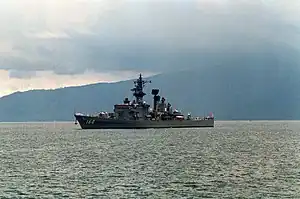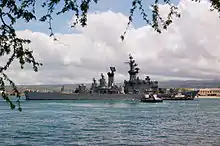Tachikaze-class destroyer
The Tachikaze-class destroyer was a second generation guided missile destroyer class, formerly in service with the Japan Maritime Self-Defense Force (JMSDF). The ships of this class have had successive improvements after their completion, especially to their C4I systems. These air-defense warships are the natural successor to the first generation air-defense ship, the Amatsukaze-class destroyer, and they were in turn, followed by newer air-defense ships, the Hatakaze class.
 JDS Tachikaze | |
| Class overview | |
|---|---|
| Name | Tachikaze class |
| Builders | Mitsubishi Heavy Industries |
| Operators | |
| Preceded by | Amatsukaze |
| Succeeded by | Hatakaze class |
| Built | 1973-1983 |
| In service | 1976–2010 |
| Completed | 3 |
| Retired | 3 |
| General characteristics | |
| Type | Guided missile destroyer |
| Displacement |
|
| Length | 143 m (469 ft 2 in) |
| Beam | 14.3 m (46 ft 11 in) |
| Draft |
|
| Propulsion |
|
| Speed | 32 knots (37 mph; 59 km/h) |
| Complement | 250; 230 (DDG168); 255 (DDG170) |
| Armament |
|
The Tachikaze class was equipped with the Tartar-D system as the key weapon system, the fleet-area air defense weapon system with the Standard-1 MR missile. At the same time, this was the American first native integrated weapon system with the Naval Tactical Data System (NTDS), so this class was the first of the Maritime Self Defense Force's ships that utilised computers widely. As the NTDS, OYQ-1 Weapon Entry System (WES) was on board on the lead ship, Tachikaze. The OYQ-1 WES was based on the technology of the NYYA-1 which was on board on the lead ship of the Takatsuki class, and this system was the first Japanese shipboard C4I system with the architecture of NTDS. On the second ship, Asakaze, the improved OYQ-2 Target Designation System (TDS) was on board. And the third ship, Sawakaze, introduced the new-generation combat direction system, OYQ-4.
The Tachikaze-class destroyers' weapon systems include one Mk 13 missile launcher for the Standard-1 MR surface-to-air missile, one Type 74 octuple launcher (Japanese version of the American Mark 16 GMLS) for the ASROC anti-submarine rockets, eight Boeing Harpoon anti-ship missile, two 20-mm Phalanx CIWS gun mounts, two Type 68 (Model HOS-301) triple 324 mm (12.8 in) torpedo tubes, and two 5-inch/54 caliber Mark 42 rapid-fire guns.
In 1998, Tachikaze was converted to be the flagship of the Fleet Escort Force. The aft 5-inch gun was replaced with a fleet command area. Tachikaze was decommissioned in 2007. Sawakaze then succeeded her in the flagship role.
The ships of the Tachikaze class were decommissioned beginning in 2007.
All three vessels of the Tachikaze class were named after destroyers of the Imperial Japanese Navy, with Tachikaze and Asakaze being lost to enemy action during the war.

Ships in the class
| Building no. | Pennant no. | Name | Laid down | Commissioned | Decommissioned | Home port |
|---|---|---|---|---|---|---|
| 2308 | DDG-168 | Tachikaze | 19 June 1973 | 26 March 1976 | 15 January 2007 | Sasebo (1976–1995) Yokosuka (1995–2007) |
| 2309 | DDG-169 | Asakaze | 27 May 1976 | 27 March 1979 | 12 March 2008 | Yokosuka (1979–1995) Sasebo (1995–2008) |
| 2310 | DDG-170 | Sawakaze | 14 September 1979 | 30 March 1983 | 25 June 2010 | Sasebo (1983–2007) Yokosuka (2007–2010) |
References
- Heihachiro Fujiki (August 2007). "A history of JMSDF's missile destroyers". Ships of the World (in Japanese). Kaijinn-sha (678): 98–103.